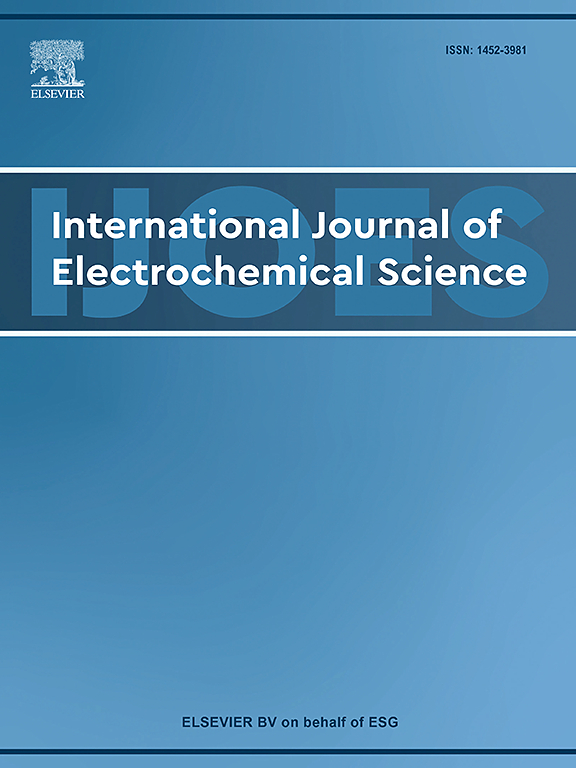Preparation and characterization of metal oxide/carbon nanotube nanocomposites for photocatalytic and photo-electrocatalytic hydrogen production: A review
IF 1.3
4区 化学
Q4 ELECTROCHEMISTRY
International Journal of Electrochemical Science
Pub Date : 2025-01-18
DOI:10.1016/j.ijoes.2025.100929
引用次数: 0
Abstract
The study of metal oxide and carbon nanomaterials for hydrogen evolution reaction (HER) catalysis stands out among the innovative solutions required by the rapid advancement of renewable energy. The potential of metal oxide catalysts to produce hydrogen is promising. In parallel, a lot of attention is being given to carbon nanotubes because of their numerous applications in environmental remediation and renewable energy. Despite an extensive amount of research on these materials, their composites, metal oxide-carbon nanotubes (MO-CNTs), remain relatively underexplored for their photocatalytic and photoelectrocatalytic (PEC) capabilities. This comprehensive study fills this knowledge gap by concentrating on the techniques used in producing and characterizing MO-CNTs composites. Aiming ways of developing methods to produce green hydrogen energy that is cost-effective. The most economical method of producing hydrogen remains to be photocatalysis. One of the important properties in photocatalysis is the band gap of the material. Many metal oxides are reported to have a high band gap; for example, recent reports indicate that TiO2 has a band gap of 3.11 eV. Upon forming the composite with CNTs, the band gap was reduced to 3.09 eV. The reduction in the band gap is responsible for improved hydrogen production. To further understand the composites of MO-CNTs, characterization techniques, including scanning electron microscopy (SEM), transmission electron microscopy (TEM), X-ray diffraction (XRD), cyclic voltammetry (CV), and chronoamperometry (CA), were thoroughly discussed. These techniques assist in understanding and improving the MO-CNTs composites and the synergy between the MO and CNTs. The synergistic effects of the metal oxides and carbon nanotubes are responsible for the outstanding enhancement in hydrogen production under light irradiation, as revealed by photocatalytic tests.
光催化和光电催化制氢用金属氧化物/碳纳米管纳米复合材料的制备与表征
金属氧化物和碳纳米材料催化析氢反应(HER)的研究在可再生能源快速发展所需要的创新解决方案中脱颖而出。金属氧化物催化剂产生氢的潜力是有希望的。与此同时,碳纳米管因其在环境修复和可再生能源方面的广泛应用而备受关注。尽管对这些材料进行了大量的研究,但其复合材料金属氧化物-碳纳米管(MO-CNTs)的光催化和光电催化(PEC)能力仍未得到充分的开发。这项全面的研究通过集中研究用于生产和表征MO-CNTs复合材料的技术来填补这一知识空白。旨在开发具有成本效益的绿色氢能生产方法。最经济的制氢方法仍然是光催化。光催化的一个重要性质是材料的带隙。据报道,许多金属氧化物具有高带隙;例如,最近的报道表明TiO2的带隙为3.11 eV。与CNTs形成复合材料后,带隙减小到3.09 eV。带隙的减小是氢产量提高的原因。为了进一步了解MO-CNTs的复合材料,对扫描电子显微镜(SEM)、透射电子显微镜(TEM)、x射线衍射(XRD)、循环伏安法(CV)和计时电流法(CA)等表征技术进行了深入的讨论。这些技术有助于理解和改进MO-CNTs复合材料以及MO和CNTs之间的协同作用。光催化试验表明,金属氧化物和碳纳米管的协同效应是光照射下氢产量显著提高的原因。
本文章由计算机程序翻译,如有差异,请以英文原文为准。
求助全文
约1分钟内获得全文
求助全文
来源期刊
CiteScore
3.00
自引率
20.00%
发文量
714
审稿时长
2.6 months
期刊介绍:
International Journal of Electrochemical Science is a peer-reviewed, open access journal that publishes original research articles, short communications as well as review articles in all areas of electrochemistry: Scope - Theoretical and Computational Electrochemistry - Processes on Electrodes - Electroanalytical Chemistry and Sensor Science - Corrosion - Electrochemical Energy Conversion and Storage - Electrochemical Engineering - Coatings - Electrochemical Synthesis - Bioelectrochemistry - Molecular Electrochemistry

 求助内容:
求助内容: 应助结果提醒方式:
应助结果提醒方式:


